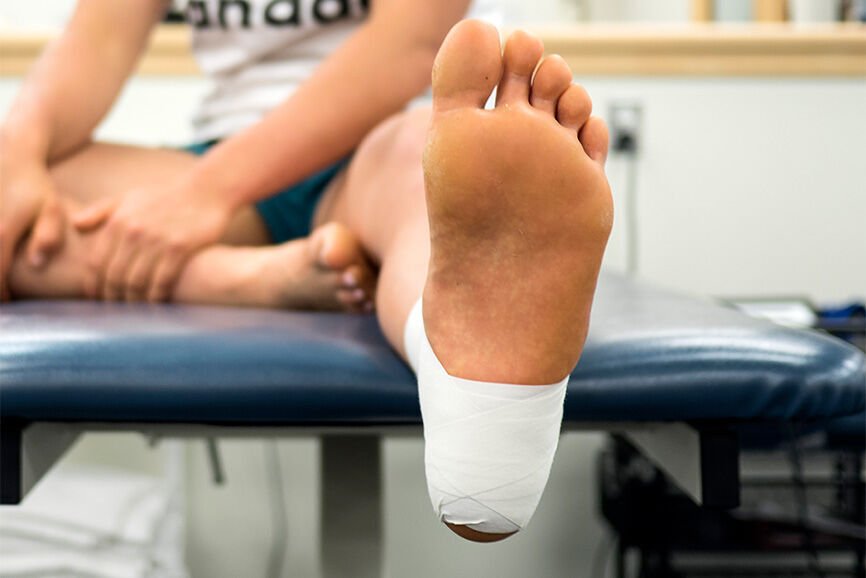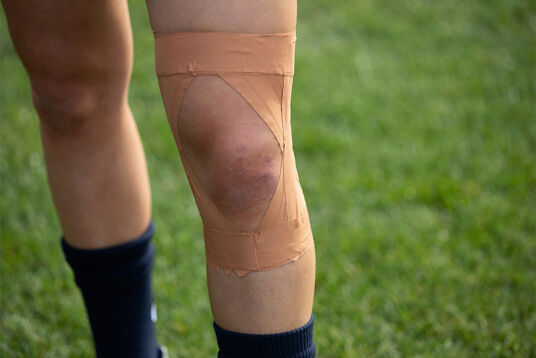Sports & Rehab
Your guide to taping like a pro this sports season
February 23, 2023

This month we share our tips on Sports Tape – a side-line essential that can help you to manage existing injuries and get back out on the field or court, rather than watching from the side-line!
If there is one thing that is sure to put a damper on a return-to-play it is injury.
Whether you are actively managing an injury from seasons past, or wanting to prevent an injury from occurring, sports tape is a great tool to assist you with injury prevention and management this season.
If this is something you can relate to but you’re asking, ‘where do I start, and what tape do I need?’ Read on for our breakdown of the different types of sports tapes and how they can be used.
Rigid Tape
Often known as the “brown tape”, Rigid Tape is designed to limit unwanted movement, and provide a high-level of support and stability to joints and tendons following an injury. Rigid tape is generally made of rayon with a zinc oxide adhesive.
Prior to choosing rigid tape, it is important to obtain the correct diagnosis of the injury to ensure that rigid strapping will be suitable.
Rigid tapes are commonly used for stabilisation of the ankle, knee, wrist, thumb, fingers, and shoulder.
Size Guide:
12mm: Fingers
25mm: Wrist, Thumb
38mm: Ankle, Knee, Shoulder, Wrist
50mm: Shoulder, Knee
Application: Rigid tape is designed to be applied to clean shaven, oil-free skin. If the user is skin sensitive, you may want to use an under wrap or fixation product. Adhesive spray can be applied to ensure extra adhesion of the tape to the skin. For the correct application for your injury, consult with your healthcare professional.
EAB Lite (Elastic Adhesive Bandage)
EAB Lite or Elastic Adhesive Bandage is used to provide compression and support to joints and is often used in conjunction with Rigid strapping tape. It is also used as lifting tape for rugby. EAB Lite is hand-tearable and made of a breathable, elastic cotton.
Lite EAB is commonly used for compression and support of the ankle, knee, thigh, wrist, thumb, fingers, shoulder
Size Guide:
2.5cm: Fingers, thumbs
5cm: Wrist, Elbow, Ankle, Head
7.5cm: Knee, Thigh, Ankle, Shoulder
10cm: Shoulder, Thigh
Application: EAB Lite is designed to be applied directly to the skin or used on-top of a Rigid or Fixation tape. If applied directly to the skin, it is recommended that the skin is clean shaven and oil-free. For the correct application for your injury, consult with your healthcare professional.
EAB Edge
EAB Edge is an elastic adhesive bandage, although unlike EAB Lite it is made of a heavier cotton fabric to provide greater support to joints. It can be used in conjunction with Rigid tape however it is not hand-tearable.
EAB Edge is used to provide support to the ankle, knee, shoulder, wrist, and elbow
Size Guide:
5cm: Ankle, Elbow, Wrist
7.5cm: Knee, Shoulder
Application: EAB Edge is designed to be applied directly to the skin or used on-top of a Rigid or Fixation tape. If applied directly to the skin, it is recommended that the skin is clean shaven and oil-free. For the correct application for your injury, consult with your healthcare professional.
Under wrap / Fixation
Under wrap is designed to be applied directly to the skin prior to taping. It is hypo-allergenic and provides a protective layer between the skin and tape and is especially for those with tape sensitivities. Under wrap is made of polyurethane. Under wrap is cohesive and adheres to itself, not the skin.
Like under wrap, fixation tape is also designed to be applied directly to the skin prior to taping to provide a protective layer between the skin and tape. Fixation tape is hypo-allergenic and porous. Fixation tape is adhesive and will stick to the skin.
Size Guide:
7cm (Under wrap)
5cm (Fixation)
10cm (Fixation)
Application: Fixation be applied directly to the skin. It is recommended that the skin is clean shaven and oil-free. For the correct application for your injury, consult with your healthcare professional.
The above information is designed as a guide only. Please consult with your healthcare professional to ensure that you select the most appropriate tape for your needs.
More related articles

Sports tape: Your guide to what, where and how
April is here and for winter sports enthusiasts it signals the start of team trials and pre-season training. The last two seasons have effectively been cancelled, so it is understandable that a lot of us will be champing at the bit to get back out there.

Our top 5 products to recover well this sports season
Those who partake in regular exercise and activity know that rest and recovery is essential to performance. However, a lot of us don’t take the time to recover properly whether that be not prioritising active recovery post workout or taking a rest day.
